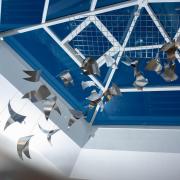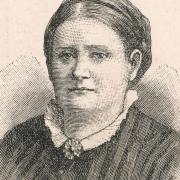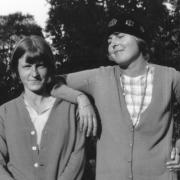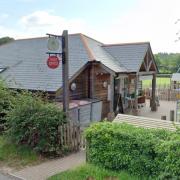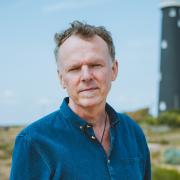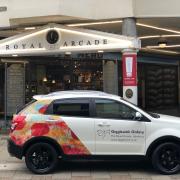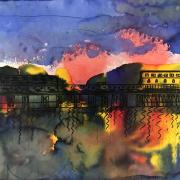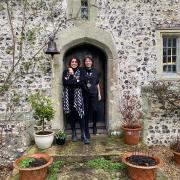It's 21 years since Charlie Burrell stopped farming the 3,500-acre Knepp Estate to allow 'nature its freedom' - here his wife, writer Isabella Tree, reveals what's new on Britain's largest rewilding project
It was the clay that did it. After 17 years of intensively working his 3,500 acre arable and dairy farm on the Knepp Estate surrounding the ancestral Knepp Castle near Horsham, West Sussex, Sir Charlie Burrell, admitted defeat. The heavy, non-draining soil made everything a challenge and unprofitable. So in 2001 he and his wife, writer Isabella Tree, made the decision to give up and let the land go back to nature.

It was the largest low-level rewilding project in Britain and by abandoning conventional farming and allowing nature its freedom they were taking a huge risk to see what happened. The result was quick and simple: life. An abundance of it. Species that were in decline began turning up. Nesting peregrine falcons, purple emperor butterflies, storks - the first back in England for centuries - and critically endangered Turtle Doves and Nightingales, which love thorny scrub, along with 13 species of bat all made their home here.
Now, 21 years later, the couple known as the King and Queen of Rewilding are full of new ideas for Knepp Wildland, the success story that has inspired people around the world to think differently about land and how much wildlife we should expect to see in Sussex and the British Isles.
It's been so successful that Sir David Attenborough mentioned Knepp in the same breath as he spoke about the nightingale's song in the BBC programme The Wonder of Song.
Along with a smorgasbord of jeep safaris, tours, and picnics that are part of their nature-based tourism, where guests can hopefully get a glimpse of the English longhorn cattle, Exmoor ponies and Tamworth pigs roaming the estate, the couple, who have two children Nancy and Edward, are farming again.

Charlie, 59, and Isabella are experimenting with regenerative agriculture - which centres around the health of the soil and limiting its disturbance - on land in villages around Shipley and Dial Post where they've created a regenerative farm to supply food to a new farm shop and cafe.

A market garden will make use of their cows' manure, and there will be farm safaris, too. But they have plenty more pioneering ideas which Isabella, author of Wilding, the best-selling book about the pioneering project, revealed during an exclusive interview with Sussex Life:
SL: Your adopted mother, Lady Anne Tree, was a renowned campaigner - did this infoluence you growing up?
Isabella: My mother came from a very privileged background and never went to school. She was taught by governesses and, ultimately, because she had no formal education, was a free thinker. A very creative ‘out of the box’ type of thinker. So, growing up, my sister and I had conversations with her that were provocative and challenging. She also was a campaigner and quite hands on, going into prisons and teaching inmates how to sew. I suppose I was rebellious as I spent much of my education in a convent school, which was very much the opposite of what I had at home. Nuns insisted you take everything on faith. But my mother’s influence meant I asked uncomfortable questions.
My upbringing helped me, perhaps, to sit comfortably with an unconventional way of thinking. Once upon a time, we had herds of aurochs, tarpan, reindeer in our [British]landscape, and wolves, elk, beaver, and wild boar. We have forgotten about this completely. Wouldn’t it be amazing to bring these herds back?
What or who was the impetus behind the rewilding?
Rewilding was really my husband’s idea. It was his vision behind this project; he made the decision to stop farming. Early on, he had trained at Cirencester agricultural college and always intended to be a farmer. When we inherited Knepp in 1987, it was losing money. But Charlie was just out of college and knew the latest technologies plus all the latest varieties of crops to plant; he was keen to diversify into ice cream and yoghurt and had ideas to make the business viable. But, during winter, it was often impossible to get farm machinery on the land. After 17 years of hard grind and astronomical debt, he realised we couldn’t go on, endlessly battling the unproductive, clay soil.
The rewilding idea was initially from Frans Vera, the Dutch ecologist, [who has turned reclaimed land in the Netherlands into one of the most densely populated places on earth by introducing the original mammals, or similar species, that would have roamed the territory thousands of years ago] and he was the inspiration behind many of these types of projects in Europe. It was about letting the land go back to scrub and introducing free-roaming herbivores again to encourage biodiversity. Charlie had big landscapes and roaming herds in his DNA, growing up in Africa and Australia so this appealed to him
What do you think about the Dutch Serengeti, the rewilding project out in the Netherlands, where bystanders were throwing hay over the fences because they were so distressed at seeing starving animals during a harsh winter?
So, with the Oostvaardersplassen, you have land recovered from the sea in one of the densest populations in Europe. The OVP experiment was important as it created a biodiverse wilderness area out of nothing. Heck cattle, Konik ponies and red deer were introduced onto this recovered land and biodiversity rocketed. These herbivores’ dung and urine helped inject life into soil that was previously inert. It’s now a hotspot for white tailed eagles, thousands of geese, spoonbills … bearded tits are now colonising Britain from this reserve.
In England we’ve forgotten that, in the wild, herbivore populations are not regulated by APEX predators. For instance, in the Serengeti large predators are only responsible for around 10% of herbivore fatalities. What regulates herds is food. What you get in the Serengeti or in Yellowstone, are natural boom and bust scenarios. Populations of animals grow during periods where there is good weather, when vegetation grows. Then, when you get a harsh season, either a fierce winter or, in Africa, a terrible drought, this causes die-off of vegetation and of animals. But we’re no longer used to seeing this.
But on the Knepp Estate, do you intervene?
At Knepp, we realised from the Oostvaardersplassen how key large herds were to creating habitat that allows other bird and plant species to come in. Obviously, aurochs and tarpan are now extinct, but we can use proxies to mimic their actions. We use old English longhorns to stand in for their ancestors, the aurochs; Exmoor Ponies mimic the tarpan, and Tamworth Pigs root around, disturbing the soil like wild boar used to do.
But we certainly weren’t prepared to allow our animals to die or to starve on our doorstep - we didn’t want to see them suffer. UK regulations would never allow that anyway. So, we cull every year to a level that ensures the herds will come through even the harshest winter in good condition. They certainly lose a bit of weight over winter but this is a natural part of the life-cycle and we don’t supplementary feed them.
During the spring, they immediately put on weight. It’s amazing to see. The animals are also self-medicating. They don’t just eat grass, but plants of all sorts. Culling the animals to a level that provides them with enough natural vegetation for winter also works in maintaining a mosaic of habitat for biodiversity. If there are too many animals, they’ll take out all the vegetation and you’ll end up with ubiquitous species-poor grassland – something you also get in the intensive farming scenario.
Is the meat from culling available to buy?
Yes, you can now buy meat from our animals, and we have just built our own butchering and maturation unit. We have a state of the art CUBO2 Smart refrigeration system – the largest of its kind - which minimises greenhouse emissions. Provenance is also key to a project like ours. Knepp animals have a whole smorgasbord of different vegetation to eat, their metabolism and immune systems are excellent, their fat is high in omega 3 meaning the meat is positive for human health. Also, because they’re eating a herb-rich diet, they emit much lower amounts of methane than animals in industrialised feedlots.
What can visitors see on safari?
A dawn safari in spring is magical and a great way to learn how to identify birdsong. Depending on the season, you can see rutting deer in the autumn, or purple emperor butterflies in July, or nightingale’s song at night in April/May. We have 25 kms of walking paths, so visitors are almost guaranteed to see at least some of our free-roaming large herbivores. Seeing cows scratching their backs on low branches, and young Exmoor colts play-fighting and pigs diving for swan mussels is wonderful.
What animals would you like to ultimately see introduced? We can’t imagine England will allow wolves back as they have in Europe.
Never say never! I’d love to think that our grandchildren or great-grandchildren will be able to make this decision. By then, some regions of our countryside may be truly wild again, with enough space to sustain wolves. Germany now has 100 packs of wolves showing it is perfectly possible to live with Apex predators again. In England, wolves would prey on a few deer, creating a landscape of fear for herbivores which is actually a good thing. We could certainly bring back lynx. As loners and stealth predators, they keep to really dense woodland so you might never even see them. Europe is leading the way as these creatures are on the rise on the continent and most people are happy to see them. Hopefully, we will follow.'





